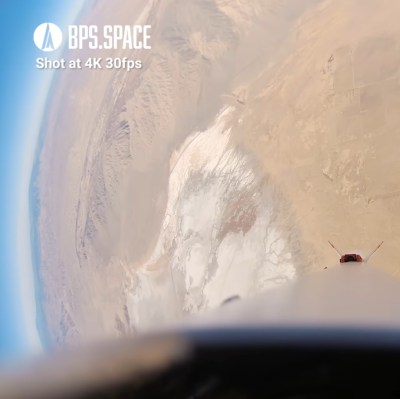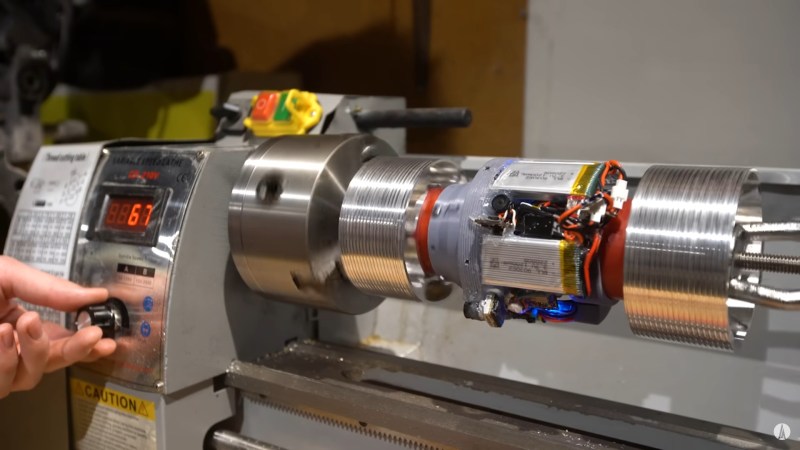[Joe] at BPS.space has a thing for rockets, and his latest quest is to build a rocket that will cross the Kármán Line and launch into the Final Frontier. And being the owner of a YouTube channel, he wants to have excellent on-board video that he can share. The trouble? Spinning. A spinning rocket is a stable rocket, especially as altitude increases. So how would [Joe] get stable video from a rocket spinning at several hundred degrees per second? That’s the question being addressed in the video below the break.

Rather than use processing power to stabilize video digitally, [Joe] decided to take a different approach: Cancelling out the spin with a motor, essentially making a camera-wielding reaction wheel that would stay oriented in one direction, no matter how fast the rocket itself is spinning.
Did it work? Yes… and no. The design was intended to be a proof of concept, and in that sense there was a lot of success and some excellent video was taken. But as with many proof of concept prototypes, the spinning camera module has a lot of room for improvement. [Joe] goes into some details about the changes he’ll be making for revision 2, including a different motor and some software improvements. We certainly look forward to seeing the progress!
To get a better idea of the problem that [Joe] is trying to solve, check out this 360 degree rocket cam that we featured a few years ago.

















This Guy is too brutal on himself.. I’d be way thrilled with what he did.. Even if it was not ‘Picture Perfect’..
Any Launch you can get the pieces back from is a Good Flight!.. His was perfect!
He has so much talent, but he is so concerned about others stealing his tech/designs. I quit watching him a few years ago. His ego is his worst enemy.
He looks like Elon with astigmatism. He ISN’T Elon.
That being said, I can’t blame him for wanting credit for any innovation. I have had some things go “miscredited” as far as intellectual property, and his stakes are much higher.
In my opinion, you can’t publish on Youtube and not expect it to be copied.
He mentions more than once in the videos I’ve seen that many of the things he does would be legally dubious (at best) to share anyway, which is a common enough thing for such projects I can believe it… And publishes on YT with build/engineering cuts that tell you just about everything you would need to know to do the work yourself and get the same result. Hardly seems like he is that worried about others with his designs to me.
I find it funny He did not notice that the camera assembly worked as a “reaction wheel”
I am entirely certain he knew it would – hard not to when you have already deliberately built reaction wheels.
Really the problem here (beyond choosing the wrong motor) was the expectation the inertia of the rocket as its spun up by the fins would exceed the robbing of that rotation by the lighter camera enough – which I think would have worked for the entire flight quite well if the camera rig didn’t overreact when it finally wakes up. It will certainly work just fine when you scale it up to a spaceshot rocket, which is what this is for – extra rocket mass, lots of it, larger and more effective fins, and the rotating mass on the camera rig is only going to get lighter as the refinements come in once its proven to work.
put the whole camera rig on a bearing and use its own fins to stabilize itself.
I love the simplicity of your idea, but,
He talked about how it’s impossible to get the fins straight enough that it doesn’t cause rotation when going mach 2. At those speeds, even the slightest defect would cause it to spin.
I would have done this, but made the fins actively controlled. You would only need a tiny degree of rotation (so you could use a big fat servo with high mechanical advantage for lots of precision).
It seems like this would be lighter, more reliable, and wouldn’t suffer from any of the issues you can have when trying to run motors at low speeds. Plus you’d have a lot of passive damping due to the fins.
I like this – until there is no atmosphere.
true, no atmosphere at higher altitudes but he wanted this for launch pictures. also regarding fin straight enough I meant for a some kind of steering system to keep it stable. stable-ish anyways. instead of depending on a servo with its issues let the air currents do the work.
Why not use a Gyroscope?
Or maybe just stop spinning the rocket?
Spinning might be a cheap way to keep pointed mostly up, but if you’re going to spend your time, mass and space on the rocket trying to stabilize the camera, why not spend those resources on sensors and active fins and do it properly?
“why not spend those resources on sensors and active fins and do it properly?”
He addresses this very question in the first 3 minutes.
Watch the video – he explains those things exactly.
Using a free-to-roll tail assembly combined with a camera stabilization rig might be a decent compromise. This approach would limit the rocket body rotation rate and angular acceleration while still providing limited rocket stabilization. It might be feasible to reduce the rocket roll rate to the point where a stepper motor could be used instead of the brushless motor and reduction gearing.
That is exactly what is used in the several years-old YouTube videos of roll stabilized camera systems on other high power amateur rockets. The free-rolling fin can spins as much as it wants to due to fin misalignment while the rocket body is kept stable by servo controlled canards.
However, his planned ultra high altitude rocket will need to spin the entire rocket to keep it stable once it reaches the altitude where fins are no longer effective, so he needs to come up with something that can’t use aerodynamic control surface to de-spin the camera section during ascent.
If you look at on-board sounding rocket videos, they intentionally spin them rapidly for the same reason, don’t bother to de-spin the camera during ascent, and then use the outward ejection of masses on cables to de-spin the entire rocket before separation of any payload section that must not spin to accomplish its tasks.
He’s way too harsh on himself. He identified a flaw before the launch, hoped it wouldn’t matter, and it turned out it did. He also got moments during the trajectory where the results were good. And most importantly: he claimed this was a prototype, not a final version.
I didn’t even watch most of the video, just skipped ahead to the absolutely gorgeous, incredibly beautiful onboard footage. Whatever this dude is moaning about, you’re cool, man.
Seems like the solution is probably something that doesn’t physically rotate the camera.
Maybe a series of stationary LCD shutters, prisms, and/or mirrors that direct the light from an open shutter to the stationary camera. Then the rocket just needs to open the shutters in the appropriate sequence as the rocket rotates in order to cancel out the rotation. Then the video frames would just need to be rotated to provide a stable view.
Was thinking sort of the same. Have the camera fixed and pointed upwards looking at a lightweight stepper-driven oblique mirror above it that can rotate 360 degrees. But the body tube wall around the mirror would need to be crystal-clear acrylic or toughened glass.
He just needs a sensored brushless motor with an appropriate ESC in order to run at slow speeds.
If you want stability without fancy moving active fins, what about using roller ons?
https://en.wikipedia.org/wiki/Rolleron
Ah ha! Finally closing the loop on that device. I’d seen them on an AIM-9 out on a flight line back in my intern days, but was in look an listen mode, and a description was not forthcoming.
I just like to say think about the casualness about which all of you are discussing the thing this article is about and think how amazing that is for a second. That we have come this far that hobbyists can not only discuss such things intelligently but attempt such projects what we have available now I’m still millennial but this is amazing. Occasionally I’m giving hope and this place gives me a lot of hope that there’s still intelligent people among us in this world.
Indeed, much as the internet can be rather toxic at times, and full of stupidity to a degree you wonder about the species, it also is quite astonishing to see how fast good ideas can spread and how fast we all start learning when folks share their expertise.
Thanks to the world of the internet I expect I’ve broken far far few cutting mill bits and got better results than if I had only old books to learn from. It also makes it possible to take on an old/cheap machine without its manual and know you can find enough information on something similar to figure out how to fix or improve it.
Not even going to check if someone said it already. Spin a mirror. Not the whole camera.